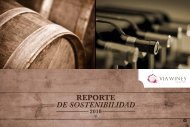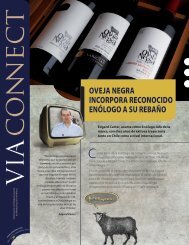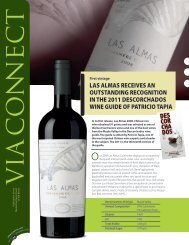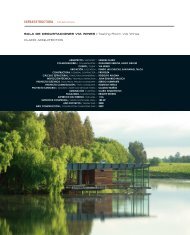Sustainability Report, Download - Via Wines
Sustainability Report, Download - Via Wines
Sustainability Report, Download - Via Wines
You also want an ePaper? Increase the reach of your titles
YUMPU automatically turns print PDFs into web optimized ePapers that Google loves.
The annual consumption of water in<br />
the Viña San Rafael cellar in 2010 was<br />
7,744 m3, which corresponds to 1.4<br />
liters of water consumed per liter of<br />
wine dispatched.<br />
EmiSSions, Effluents, and Waste<br />
VIA <strong>Wines</strong> implemented the use of<br />
Biomass Boilers that burn wood chips.<br />
This material is a byproduct of lumber<br />
companies in the area of the winery.<br />
Emissions in this system are considerably<br />
lower than those generated by<br />
boilers that use liquid gas (the system<br />
formerly used by the winery), due to<br />
the nature of gas as a fossil fuel.<br />
Sewage<br />
Liquid industrial wastewater (LIW)<br />
goes through an aerobic treatment<br />
system that consists of a reception<br />
area and the discharge of liquid waste<br />
to a pond designed for aerobically treating<br />
the water. The treated liquid waste<br />
is within the parameters established in<br />
Standard 90, for surface water runoff.<br />
This system is approved by the SISS,<br />
which monitors compliance with the<br />
Standard. In 2010, 9,600 m3 of LIW was<br />
generated.<br />
Cardboard & Paper<br />
For the purpose of recycling cardboard,<br />
VIA <strong>Wines</strong> has established an<br />
agreement with a company belonging<br />
to Rodolfo Ortiz (Resolution Nº 606) to<br />
provide containers to store the waste<br />
products and remove them when they<br />
are full.<br />
For recycling paper waste generated in<br />
its San Rafael and Santiago offices, VIA<br />
<strong>Wines</strong> has established an agreement<br />
with the Sorepa S.A. company to remove<br />
the paper that has been stored in<br />
containers provided for that purpose.<br />
In 2010, a total of 100 tons of cardboard<br />
was removed.<br />
The same company also removes plastic,<br />
glass, metal bands, and nylon from<br />
our premises. The company provides<br />
containers for the proper storage of<br />
these waste materials and returns to<br />
remove them when they are full.<br />
The volumes removed in 2010 were:<br />
• Nylon: 22 tons<br />
• Glass: 319 tons<br />
Waste<br />
VIA <strong>Wines</strong>’s principal waste derives<br />
from the trash generated in its offices:<br />
cardboard, paper, plastics, glass,<br />
metal bands, lees, filtering earth, and<br />
organic waste such as pomace and<br />
stalks. A total of 735 m3 of waste was<br />
generated in 2010.<br />
29






